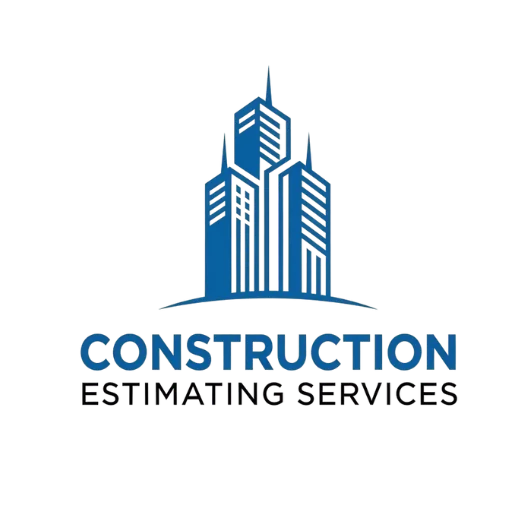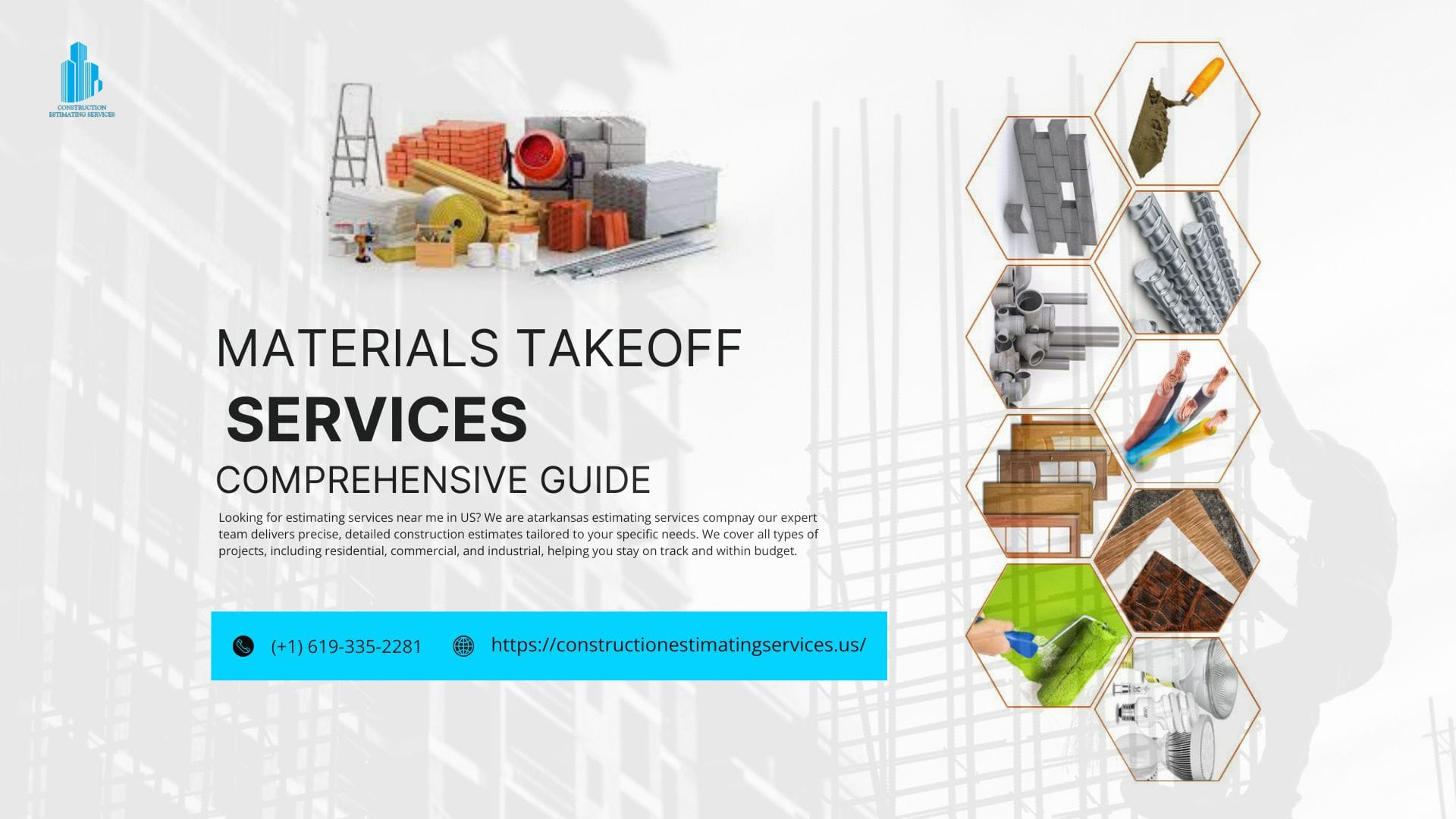Material takeoff services are the key to the planning and executing of construction projects. This article aims to help readers clearly understand this essential process.
Material takeoff, or MTO, is a technique for measuring the materials necessary for a construction project. This can be the best method of deciding what materials are needed for a particular project. Material take-off processes are based on a close examination of project blueprints, and the itemized list of required materials and their quantities is developed in this manner.
Material Takeoff: A Key Component in Construction Projects
Material Takeoff is a vital phase stage in construction projects. In this process, one studies the construction drawings and project details to create a refined list of materials required for the job. Thus, it includes cataloging several items like boards, concrete, steel, and other components used in construction. The list formed by this process handles several functions, including estimating quantities and controlling inventory.

The Material Takeoff also grants the foresight to predict a lack of materials or overstock, hence the possibility of solving things in time. It’s a comprehensive course with no margin for error that necessitates a high level of attention to detail and correctness. Otherwise, money gets wasted, and construction work extends. Complete and all-encompassing material takeoffs are the central mechanisms that enable swift project implementation. Doing this establishes the significant step of developing highly detailed Material Takeoffs early in the process.
info@constructionestimatingservices.us
How Accurate Material Takeoff Improves Project Efficiency
The quality of material takeoff significantly improves project efficiency in several aspects.
Initially, the precise ordering of materials through the use of materials takeoff systems effectuates accurate cost control, which can outweigh both over-ordering and under-ordering expenditures, enabling the reduction of waste materials and the minimization of unexpected expenses. Furthermore, it also improves time management, as the materials are upon requisition. Hence, there are no more delays caused by material shortages.
Additionally, accurate takeoffs are instrumental in facilitating project planning. Allocating green materials also ensures that the project duration becomes more predictable. This, in turn, minimizes the mistakes made during construction works due to wrong materials or quantities, reducing the need for rework.
Instruments such as digital takeoff software, 3D models, and Building Information Modeling (BIM) have made the material takeoff process more accurate and efficient. What these tools, first of all, do is that they provide concrete images as well as automatic calculations, which further help to enhance project efficiency.
Types of Material Takeoff
Several features fall under the category of material takeoff, which is tailored to the requirements of a particular project. The said subtypes are thus:

1. Preliminary Takeoff
Preliminary takeoff is provided at the halfway point of a project when a product design may not yet be ready. The process provides a loose collection of the necessary materials and related expenses. It allows the project managers to evaluate the project’s viability and decide on the budget and possible modifications in the design.
Even with the preliminary takeoff, the final takeoff can be more accurate because the preliminary takeoff is conducted based on incomplete information. Nevertheless, it is a potent tool mainly for budgeting and deciding on project activities early on.
2. Detailed Takeoff
When the final project plans and specifications are available, a thorough takeoff is carried out. This kind of takeoff accurately shows the necessary materials and their costs. The project team uses it in procurement, budgeting, and scheduling.
You must recognize detailed takeoff on significant and complicated projects where material quantities are crucial in ensuring the project is on time and within budget.
3. 3D Model-Based Takeoff
In the era of technological revolution, 3D model-based takeoff is becoming the answer in the construction industry. Using building information modeling (BIM) software, they create a digital 3D model of the project. The software automatically calculates the material amounts needed from the model, which means the takeoff process is cut down and more accurate.
Indeed, 3D model-based takeoff has a few overall benefits, such as being easily visualizable in three dimensions, modeled for simulation of potential design clashes, and adapted before the building process starts.
Key Components for Material Takeoff
An efficient material takeoff demands experts to master certain basic components. These elements are the starting point for a successful material list and assist in correctly calculating the entire process.

Understanding Construction Drawings and Blueprints:
Construction drawings and blueprints are the visual presentations of the design of a construction project. They provide specific information about the layout, dimensions, specifications, and materials. Being conversant with various drawings, such as architectural, structural, mechanical, and electrical, is integral to accurate material takeoff. Key Considerations:
Architectural Drawings: These diagrams illustrate the project and include floor plans, elevations, and sections. They reveal the look and the arrangement of spaces.
Structural Drawings: Structural drawings aside from the project’s structural components, such as beams, columns, foundations, and load-bearing elements. They instruct the builders in constructing the project’s supporting structure.
Mechanical and Electrical Drawings: These are the drawings that identify the project’s mechanical and electrical systems, which include plumbing, HVAC, and electrical wiring, among others.
The professionals doing the material takeoff must be familiar with such drawings. They not only help the professionals recognize and define the needed materials for each part but also assist them in estimating the measurements correctly.
The Role of Technology in Material Takeoff
Technology is rapidly changing the process of material takeoff and delivering a new experience. The traditional methods are still part of the process, but high-speed, accurate, and less time-consuming digital tools are on the rise. In particular, here are some of the latest technological advances:

1. Takeoff Software
Takeoff software is no longer new to the construction industry. The applications have reduced labor requirements so that digital takeoff can be done smoothly and more quickly. The applications wherein contractors supply blueprints to estimators are automated to measure and quantify materials as per the sketches instantaneously. The most prominent examples of these takeoff software applications are PlanSwift, Bluebeam Revu, and On-Screen Takeoff.
Takeoff software not only saves the time required for the takeoff process but also enhances the accuracy of measurements by minimizing human errors. It provides users with the advantage of producing detailed material lists, applying costs, and exporting the takeoff data to spreadsheets or estimating software.

2. Building Information Modeling (BIM)
Through BIM technology, the developer, the owner, or any other client will have access to the detailed 3D model of the project, thus being able to monitor, evaluate, and execute it. After the project is completed, architects are eligible to create a 3D digital model of the building and a 2D floor plan, which gives details and the size of all the elements used in the building.
Through the application of the principles of Building Information Modeling (BIM) in material takeoff, contractors can retrieve information on materials directly from the 3D design; thus, the initiators’ need to input dimensions, quantities, or other personal errors is obviated. Also, BIM eases communication among the parties involved in project maintenance, giving more input to the architects, engineers, and contractors so that they can work together more successfully.
3. Cloud-Based Collaboration Tools
Construction teams can readily share project data and collaborate in real time using cloud-based collaboration tools. These tools provide estimators, project managers, and contractors with direct access to the material takeoff data from any location, thus ensuring that everyone is using the most recent version of the information.
Step-by-Step Guide to Performing Material Takeoff
One way to achieve precise material takeoff is to use a big scheme that checks all materials, ensuring they are identified, described, and accounted for in planning effectively. It is almost the same whether it is done manually or digitally; the following steps are going to explain the material takeoff process:
- Reviewing Project Documentation: Firstly, the project drawing, building plans, and, if available, the cut sheet supplied by the manufacturer can be examined more in-depth. This can help decide on the type of input needed and the type of materials. Learn what the project involves, the work proposal, and the design details. This stage is designed to ensure you thoroughly comprehend the project’s work and materials.
- Identifying Materials for Takeoff: Given the project specifications, one should single out all the materials required for every structural component of the project. This involves using a number of items, such as structural components, finishes, and fixtures. Make a detailed table of the materials you will need, grouping them by type or location for more approachable organization.
- Measuring and Quantifying Materials: Accurately measure the dimensions for each material using the correct units of measurement (length, area, volume, count, weight). This procedure may be executed manually using measurement equipment or digitally using software specifically designed for it. Calculate the amounts that you will need from measurements and ensure that they are accurate and consistent.
- Calculating Waste and Adjustments: Waste due to cutting, adjusting, or stock(which can be used in the example) should be added to the final material estimation through the corresponding factors of conversion outdoing the standard industry room waste. These factors differ from material to material and may also depend on the project. Incorporating additional allowances such as material overlap, cutting composites, and similar materials can ensure that the quantities calculated are usage-based rather than theoretical.
Benefits of Outsourcing Material Takeoff Services
Many construction companies opt for specialized firms to handle material takeoff by outsourcing, which is a profoundly logical decision for them. Here are some of the benefits of outsourcing material takeoff:
1. Expertise and Accuracy
Their expertise and skills make them takeoff service providers who know how to carry out exact calculations for different construction projects. Their construction-related skills and knowledge, attained through familiarity with materials and methods, enable them to make a precise takeoff that is free of errors and discrepancies.
2. Time Savings
Accurate material takeoff can be a very long procedure, particularly for lengthy and complex projects. Subcontractors rely on efficient professionals to handle this task, and they can invest the time they save on other crucial project elements, such as project management and client communication.
3. Cost Efficiency
The cost savings of material takeoff can be another reason for outsourcing since such a method allows canceling the in-house estimators’ in-house cost and the huge cost of software acquisition. Material takeoff service providers emerge as competitive market players offering cheap, making the process quick, enabling contractors to stay on budget.
Obviously, a company that can deal with numerous projects at the same time will be fulfilled. Performing material takeoff can generally be done by employing external take-off services that handle multiple projects concurrently. Thus, they undertake every takeoff promptly in spite of the scale or complexity of the project.
A Guide to Material Takeoff Challenges and Pitfalls
Getting the proper material takeoff is one of the most significant aspects of a construction project, but it always comes with problems. Whether done manually or not, workers should know what to look for and avoid to achieve a faster and more reliable material takeoff process. The Most Common Mistakes in Manual Takeoff:
- Measurement Errors: When an operator merely indicates the dimensions and locations of the lines, mistakes during manual measurement occur due to errors or outright wrong interpretations of the drawings by humans.
- Miscalculations: The input of wrong numbers during manual quantification can result in dead wrong ease of errors and, hence, the wrong estimation.
- Omissions: Drawing inclusions and highlighting all the details ensures that complete material takeoffs are provided and that no material issues ensue during construction.
- Units Conversion Mistakes: The misuse of units can be the root cause of errors and discrepancies generated during calculations through the services of a well-versed converter.
- Waste Calculation Errors: Exaggerating the amount of waste generated at a construction site can result in either too much waste being ordered or material shortages.
Steering a Safe Voyage to Avoid Pitfalls in Custom Projects:
- Different Types of Material: A comprehensive understanding of the properties of each material used in projects that incorporate diverse material textures is a must by engineers and other project personnel.
- Unorthodox Designs: This fact may make quantifying proper material sizes challenging since they may not have been measured using the normal method.
- Inter-professional Collaboration: Architects, engineers, and contractors work together to complete such designs since they are complicated, which is problematic because of design.
- Changing Scope: The need for an evergreen change of designs and scopes during a project may require regular updates to material takeoff data.
Overcoming Challenges with Digital Takeoff:
- Learning Curve: Implementing software tools implies the process of training and perception, which might be the first time taken off.
- Software Complexity: Several digital tools might offer multiple functions; however, using them efficiently can challenge one’s learning curve.
- Data Entry and Consistency: Making data entry errors is similar to leaving it blank; hence, you would never understand what the issue was with the materials, whether it was installation, material takeoff, or purchasing.
- Software Integration: Combining digital takeoff software with other construction management tools may require technical expertise and careful set-ups.
Mitigating Challenges and Enhancing Material Takeoff:
- Training and Education: Regular refresher courses and additional education are required to keep professionals ahead of the curve and at pace with evolving technology.
- Quality Control: By checking to see if a real error has occurred in the programs at their specific location, peer reviews help decrease the possibility of mistakes appearing on the project during the next procedure.
- Collaboration and Communication: The more effective the communication between project stakeholders, the easier it is to explain the rules of quantity and maintenance.
- Use of Templates and Standards: A standardized measurement guideline along with a template can be used to avoid mistakes and eliminate inconsistency.
- Leveraging Technology: With AI future development, digital takeoff tools may reduce the number of errors in the operation. This will obviously result in a more streamlined and efficient process and enhance the accuracy of the construction project.
Conclusion
Material takeoff is a fundamental construction process that serves as the base of precise cost estimation, resource planning, and project management. Whether performed manually or with the aid of state-of-the-art software and technology, material takeoff ensures that construction projects are finished efficiently and within budget and time.
Since technology is ever-changing, the material takeoff process has become more streamlined and precise, making it possible for construction professionals to concentrate on providing high-quality projects with minimal waste and maximum cost control. Whether you opt to do the material takeoff in-house or outsource it to a specialized service, the importance of the correct and fast material takeoff always remains the same in the construction industry.
By gaining a deep insight into material takeoff and using the latest tools and techniques, contractors and estimators can ensure the success of their projects from the initiation to the end.












